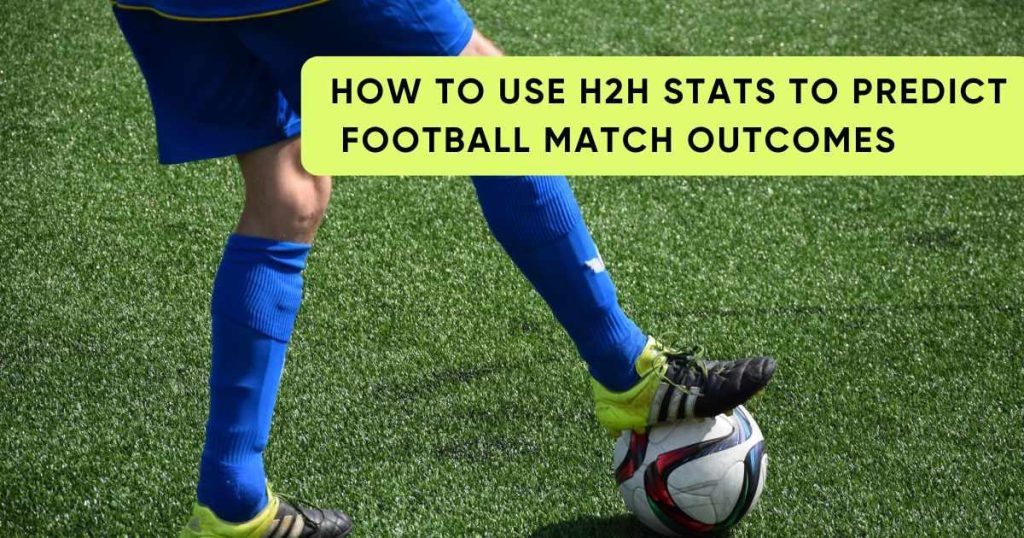Head-to-head (H2H) football statistics play a significant role in match forecasting because they summarize the historical interactions between two teams. These records reveal recurring patterns, tactical mismatches, psychological dominance, and situational tendencies that regular form tables cannot always capture. By studying H2H data, analysts can identify how a matchup typically unfolds, which team historically has the advantage, and how past outcomes align with current conditions.
For fans and bettors, understanding H2H data opens up more accurate prediction opportunities. Instead of relying solely on recent form, which can be influenced by short-term fluctuations, H2H statistics provide a long-term perspective. They help determine whether past performance consistency exists between specific opponents and what kind of match behavior tends to repeat. Before exploring deeper layers of tactical and statistical interpretation, it is essential to clarify what head-to-head statistics actually represent and how they are structured.
Understanding What Head-to-Head Statistics Represent
Head-to-head statistics capture the history of two teams’ encounters, including results, goals scored, goals conceded, tactical patterns, and psychological dynamics. They reveal how certain teams respond to each other’s strategies over time, making them a core component of predictive analysis.
H2H data is more than a simple record of wins and losses; it often reflects stylistic conflicts, strengths exploited repeatedly, or weaknesses consistently exposed. For example, some teams may struggle against high-pressing opponents but excel against deep-block defenses. These tendencies become clear when the historical matchup is analyzed over multiple seasons.
Understanding H2H statistics lays the foundation for breaking down their components in more detail, helping readers interpret both surface-level and underlying patterns in football matchups.
Core Components of Head-to-Head Data
H2H data comprises several components that collectively illustrate historical competitiveness between teams. These include win/loss records, total goals scored, average goal margins, specific outcomes at home or away, and recurring tactical behaviors seen in previous meetings.
By breaking down these components, analysts can determine whether a matchup is historically balanced or dominated by one side. They may also locate patterns like slow-starting matches, aggressive second halves, or consistent vulnerabilities in set-piece defense or counterattacks.
Understanding these components sets the stage for deeper exploration, especially regarding the metrics used to evaluate the significance of historical performance.
Key Metrics for Evaluating Historical Match Performance
Evaluating historical match performance requires attention to specific metrics that highlight consistency and relevance:
- Goal differential gives insight into competitive balance.
- First-half vs second-half trends show where momentum often shifts.
- Scoring timelines indicate vulnerability at certain match moments.
- Frequency of draws or high-scoring matches helps estimate match flow.
- Home/away splits reveal environmental influence on outcomes.
These metrics help analysts determine whether past encounters followed recognizable patterns. With these essentials covered, the next key area to understand involves contextual factors that modify the significance of H2H records.
Contextual Factors That Influence Head-to-Head Results
H2H outcomes do not exist in isolation. They are deeply influenced by contextual elements such as venue, weather, player availability, and match importance. A team may dominate an opponent historically but struggle when playing away due to environmental challenges or travel fatigue. Likewise, weather conditions such as heavy rain or strong winds may disrupt certain tactical styles more than others.
Match importance also shapes H2H performance. Some teams perform differently under high-pressure circumstances, such as cup finals or rival matches. Injuries, suspensions, and squad rotation likewise influence consistency, changing the dynamics of expected outcomes.
Contextualizing H2H data enables analysts to move beyond static results and examine how situational influences affect historical patterns. This sets the pathway for deeper tactical analysis.
Tactical Interpretation of H2H Patterns
Tactical analysis is a critical component of understanding H2H statistics. Historical matchups often reveal the tactical dynamics between two teams: pressing intensity, positional play, transitions, defensive arrangements, and formation mismatches. When these tactical tendencies appear consistently, they help explain why one team tends to outperform the other.
For instance, a possession-based team may struggle against an opponent that excels at rapid counterattacks. Conversely, a team known for pressing may dominate opponents with weaker build-up play. By evaluating tactical tendencies observed in H2H encounters, analysts can understand not just what happened but why.
How Playing Style Mismatches Shape Historical Trends
Playing styles often govern how matchups unfold. Analysts reviewing H2H trends typically examine:
- Pressing vs build-up dynamics.
- Counterattacking efficiency vs possession control.
- Wide play dominance vs central block resilience.
- Set-piece success rates.
- Transition vulnerabilities.
These factors allow analysts to identify style mismatches that persist across seasons, revealing why some teams repeatedly dominate others regardless of temporary form shifts.
Once these tactical relationships are understood, the analysis naturally progresses toward individual player influence reflected in H2H outcomes.
Player-Level Influence on Head-to-Head Outcomes
Individual players can have disproportionate effects on H2H performance. Certain forwards consistently score against particular teams, while some defenders struggle against specific types of attackers. Creativity, pace, aerial dominance, and defensive positioning all shape how individuals fare in recurring matchups.
Player chemistry also matters. Some midfield partnerships consistently dominate opponents due to synergy, pressing coordination, and controlled tempo. Analysts examine these trends to understand how player matchups contribute to overall H2H patterns.
Understanding individual contributions helps analysts appreciate how player availability and form affect prediction accuracy. This sets the stage for applying predictive models that integrate H2H data effectively.
Predictive Models Incorporating H2H Data
Predictive models provide statistical frameworks for forecasting match outcomes using historical and contextual metrics. H2H data is often a key variable within these models because of its demonstrated relevance in specific matchups. Common models include:
- Poisson distribution for probability of goal events.
- ELO ratings for relative team strength.
- Bayesian updating, adjusting predictions based on recent data.
- Monte Carlo simulations to estimate probability ranges.
- Machine learning algorithms that combine multiple data inputs.
These models evaluate H2H data alongside form, xG trends, tactical metrics, and player statistics. Analysts use these models to create probability grids for outcomes like win/draw/loss, total goals, and scoring likelihood.
Combining H2H Trends with Modern Predictive Metrics
To integrate H2H insights into modern predictive analysis, analysts follow structured steps:
- Review historical matchup patterns.
- Evaluate tactical fit and style mismatches.
- Analyze xG and xGA trends for current form.
- Adjust for lineup changes and player availability.
- Incorporate probability outputs from statistical models.
This layered approach increases the accuracy of match predictions by blending historical context with modern performance indicators. Yet, even with strong frameworks, analysts must avoid common mistakes in interpreting H2H data.
Common Mistakes When Analyzing Head-to-Head Statistics
A common error is placing too much weight on outdated H2H results. Football evolves constantly—tactics change, players rotate, and coaches adapt strategies. Therefore, H2H records from five years ago may be less relevant than more recent encounters.
Another mistake is ignoring match context. A dominant historical record may hide the fact that many of those wins occurred at home or against weaker lineups. Analysts must also recognize when team identities change dramatically, rendering old H2H data less predictive.
Avoiding these mistakes ensures more reliable analysis and sets the stage for strategies that improve prediction accuracy.
Strategies to Improve the Accuracy of H2H Analysis
Accuracy improves when analysts apply systematic methods. Weighting recent H2H encounters more heavily increases relevance. Adjusting for player availability, tactical evolution, and coaching changes also strengthens forecast reliability.
Scenario-based adjustments sharpen interpretation. For example, if a team historically struggles against counterattacks, analysts must evaluate whether the opponent still excels in this area. Similarly, identifying shifts in defensive or offensive patterns helps contextualize H2H records.
Using these improvement strategies helps analysts form more accurate assessments before leveraging advanced tools.
Tools and Technologies for Professional H2H Analysis
Professional analysts use powerful tools to uncover deeper insights in H2H statistics. These include:
- Statistical dashboards displaying multi-season H2H trends.
- Tactical simulators recreating matchup dynamics.
- AI-driven scouting platforms offering detailed player comparisons.
- Video analysis tools highlighting recurring game patterns.
- Machine learning engines for automated predictive outputs.
These technologies enhance the depth and accuracy of H2H interpretation by blending statistical rigor with tactical visibility. They enable experts to see beyond surface-level data and uncover actionable insights.
Related Football and Entertainment Insights
Head-to-head analysis is just one pillar of understanding football match dynamics. Fans wanting to explore more predictive analytics, tactical breakdowns, and sports entertainment can access broader resources. One such platform is ufabet, offering football content, market insights, and a wide array of related sports tools. These resources help fans deepen their analytical skills and enjoy the game with clearer understanding.
By mastering how to read and interpret H2H statistics, fans and analysts gain a significant advantage. Whether forecasting outcomes or studying tactical evolution, this systematic approach to historical match data brings clarity and precision to football analysis.

